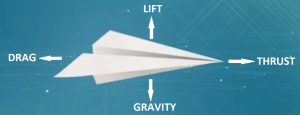Why take the Paper Planes Challenge?
This challenge encourages you and your family to think about the maths involved in the design and construction of paper planes.
By making paper planes and testing them to see how far they can go you will learn about geometry, measurement and data displays.
Get ready to take to the skies.
Real life connections
In Victoria, the aviation and aerospace industry comprises over 150 companies and employs more than 17,000 people. Work in this industry may entail:
- airframe design, manufacture and testing
- precision engineering and ground support equipment
- aircraft maintenance.
1. Setting the Scene
Before getting started, think about the four main forces that act on paper planes.
Thrust is the forwards force generated when you throw your paper plane. A real plane generates thrust from its engines.
Gravity is the downwards force acting on your plane to pull it towards the ground. Without gravity we would all float away just like in space.
Drag is the force that slows the plane down due to air resistance. If you have ridden your bike on a windy day you would have felt the effects of drag slowing you down.
Lift is the force that pulls the plane towards the sky. When the plane flies forward the air that moves under the wings provides this upwards force.
Links to the Curriculum
Maths words
drag – a force which slows objects due to air resistance.
estimation – an approximate calculation of something.
gravity – the force that pulls objects on earth towards the ground.
lift – the upwards force caused by pushing air downwards.
thrust – a generated force which moves an object forward.
Find more maths words in the Glossary.
2. The Challenge
Construct a squad of paper planes and estimate how far each plane will fly.
1. Give each person in your family who is involved in this challenge a piece of A4 paper.
2. Collect the following: a pair of scissors (for some plane designs), a ruler to help with folding (optional), a tape measure to measure flight distance (optional); a stopwatch to measure flight time (optional); and textas to decorate your designs (optional).
3. Start designing and making paper planes.
4. Even though you are competing with other family members to see whose plane can fly the farthest, talk with each other about the positives, negatives and interesting points of each design to help make everyone’s plane better.
5. Once everyone is satisfied with their plane, draw a table where each person records an estimation of how far their plane might fly and how long their plane might stay in the air. Think about units of measurement that could best be used for distance – would metres, centimetres or millimetres be best? Think about units of measurement that could best be used to record flight time. Do you think hours, minutes or seconds would be best?
6. Launch your planes.
7. Grab a camera to capture images or video of your planes.
8. Reflect: who in your family made the plane that flew the furthest? Who in your family made the nearest estimations regarding their plane’s flight distance and time in the air?
Advice
If you are stuck, here are some suggestions that might help.
When you are folding your planes don’t rush. Make sure your planes are well folded. Spend some time rubbing your finger along the folds after you make them.
Throwing your plane is just as important as making your plane. Try throwing your plane at medium pace and pointing the front of the plane upwards.
3. Keep Going
Take a paper clip (or more than one if you want) and add it to different areas of your plane before flight. What changes does the paper clip cause?
If you are lucky enough to have a piece of A3 paper, try making your plane with A3 paper. Does the A3 version fly further than the A4 version?
Take another sheet of A4 paper and some tape. Try and make an extension for the wings on your plane and see if a plane with longer wings flies further.
Try making your paper plane out of a different material. Consider using thicker paper or newspaper and comparing the flight of the planes.

